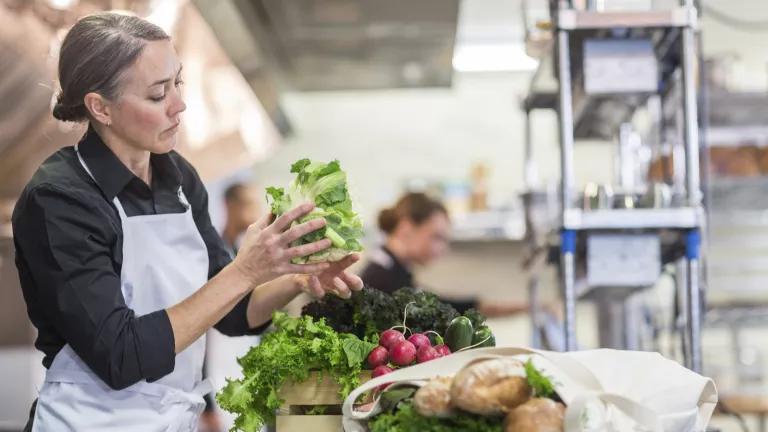Stop Food Waste: Redistribution and Upcycling Opportunities
NRDC and our partners at Drexel Food Lab are raising awareness about expanded donation liability protections and upcycling opportunities for food businesses.

This blog is co-authored with Jonathan Deutsch, PhD, Professor and Director, Drexel Food Lab which is a food product design and culinary innovation lab centered on improving the health of people, planet, and economies. The lab is staffed by students, from undergraduate through doctoral, in fields as diverse as culinary arts, nutrition, food science, data science, graphic design, and design research.
In our country, up to 40% of food goes to waste, mostly ending up in landfills or incinerators rather than on people’s plates. To help combat this, the U.S. Environmental Protection Agency (EPA) created a tool to help guide food waste reduction efforts called the Wasted Food Scale. It details the ways to handle excess food or food scraps, from most preferred to least based on the environmental benefits of each method. The best way to limit the negative impacts of food waste is to prevent food from becoming waste in the first place. But some excess is inevitable. When there is excess food that cannot be prevented, the next best solution is to rescue and redistribute it to make sure it gets to people’s plates or upcycle it into new value-added food products. A resilient food system is one that has different pathways to deal with excess food to ensure that as little as possible is wasted.
Rescue and Redistribution
Food rescue is an important step in addressing excess food by redistributing surplus food from restaurants or food businesses to individuals experiencing food insecurity. According to ReFED, reducing barriers to and increasing capacity for food rescue could mean an additional 2.3 million tons of food available for redistribution annually, with a net financial benefit of nearly $9 billion. Since 1996, the Bill Emerson Good Samaritan Food Donation Act has provided liability protection for restaurants and other food businesses that donate surplus food. However, the protections under this act were often not well understood; businesses were hesitant to donate food due to misperceptions about liability concerns associated with donation, such as fears of a food recipient becoming ill. In fact, a 2016 survey by the Food Waste Reduction Alliance found that 50% of food manufacturers and 25% of retailers and wholesalers were reluctant to donate food due to liability concerns. Another study conducted by ReFED suggested that there was potential to rescue an additional 57,000 tons of surplus food per year if there were more education on liability laws for potential food donors. These studies underscored the need to bolster the Emerson Act to strengthen the original legislation and provide guidance and best practice to increase the amount of food being donated.
The Food Donation Improvement Act (FDIA) did just that – FDIA was signed into law in January 2023 by President Biden and expanded liability protections in two ways:
- FDIA expands liability protections to donors donating directly to individuals. This change expands protections for food businesses that would like to directly donate to individuals and community organizations that are not registered as 501c3 organizations. This opens more pathways for food donation that are more flexible and meet communities where they are.
- FDIA extends liability protections to donated food that is then sold at a “Good Samaritan Price,” which is a price equal to or less than the cost of handling and distributing the food. Redistributing food can be a costly endeavor and offering food at a low price can help offset some of the costs. This addition expands protections for entities like social supermarkets and other innovative food hubs that can provide more options for people to access food.
Upcycling
Upcycling food is on the same tier of the Wasted Food Scale as food donation. The Drexel Food Lab, which focuses on food product design and culinary innovation, has been working with industry partners in the manufacturing and foodservice sector to turn surplus food (e.g. from manufacturing remnants or overproduction) into value-added food products called upcycled foods. Based on research conducted at the Drexel Food Lab, the Upcycled Food Association defines upcycled foods as “foods [that] use ingredients that otherwise would not have gone to human consumption, are procured and produced using verifiable supply chains, and have a positive impact on the environment.” For example, if a catering group has extra meals, those are better suited for donation, but if a brewery has spent grain, that is a better candidate for upcycling.
Drexel Food Lab’s upcycled food clients include Reveal Avocado Seed Brew, Bake Me Healthy, Matriark Foods, Agricycle, and TBJ Gourmet. An illustration of Drexel Food Lab’s upcycling work in collaboration with Bimbo Bakeries USA can be seen below.
Surplus food rescue and upcycling are pivotal to reducing the amount of food going to waste in landfills and incinerators and are critical components of a resilient food system. By emphasizing that food is made to be eaten and sharing the achievements being made at both the federal and industry levels, we can continue to expand the opportunities for more creative solutions to combat wasted food.




